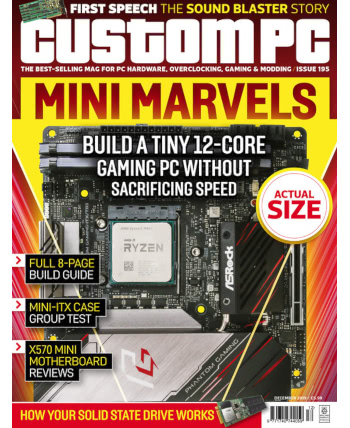
First, the Argon 1 Pi 4 case. Externally, this looks a lot like the Argon One reviewed back in Issue 188; internally, though, things have been shifted around to provide support for the latest Raspberry Pi 4 single-board computer – and the brown-outs caused by the smart power and cooling board drawing too much power are now a thing of the past.
As with its predecessor, the Argon 1 Pi 4 is impressively solid and does a great job at cooling the Raspberry Pi 4 by using the aluminium housing as a heatsink – even running a heavy synthetic workload, the temperature didn’t reach the minimum required to activate the built-in PWM-controlled cooling fan. It also adds some neat features, such as a labelled and colour-coded GPIO header, neater cabling through the shifting of audio and video ports to the rear, and a smart power button.
Shortly after the review was completed, but thankfully before the magazine went to press, the power board on the Argon 1 Pi 4 died – thankfully without taking the Raspberry Pi 4 with it. The review was updated accordingly, and since then Argon 40 has been stellar in attempting to resolve the problem – paying to have the faulty board returned for analysis and replacing both the faulty board and the entire unit in order to get things back up and running. While it will be a short while before it’s clear whether the failure was a one-off or not, it’s certainly impossible to fault the company’s customer service ethos.
The Sipeed Longan Nano, supplied by Seeed Studio, is an interesting beast: costing less than $5, the board is based on a low-power RISC-V microcontroller with a breadboard-friendly board design and a built-in low-resolution colour LCD display. For the money, the hardware is absolutely incredible – especially as Seeed has even designed a rough but serviceable acrylic case for the board, bundled at no additional cost.
The software and documentation, however, is definitely an issue. The libraries provided failed in a variety of ways – including an inability to use printf() or open a serial port – and the English documentation is extremely sparse. Particularly lacking is anything to demonstrate the use of the LCD – bar a single example program documented using Chinese in-line comments.
Finally, Arcade Game Typography. I’ve reviewed a lot of retro-computing coffee-table books over the years, but Omagari’s book is the first to concentrate solely on fonts and typography as used in classic arcade games – and given Omagari’s work as a designer for Monotype UK, it’s fair to say he knows his stuff. The result is a fascinating book, and one which is currently available in a limited 1,000-copy hardback print run from Read-Only Memory if the standard paperback isn’t shiny enough for you.
Custom PC Issue 197 is available on supermarket and newsagent shelves now, or can be ordered for global delivery from the official website.

